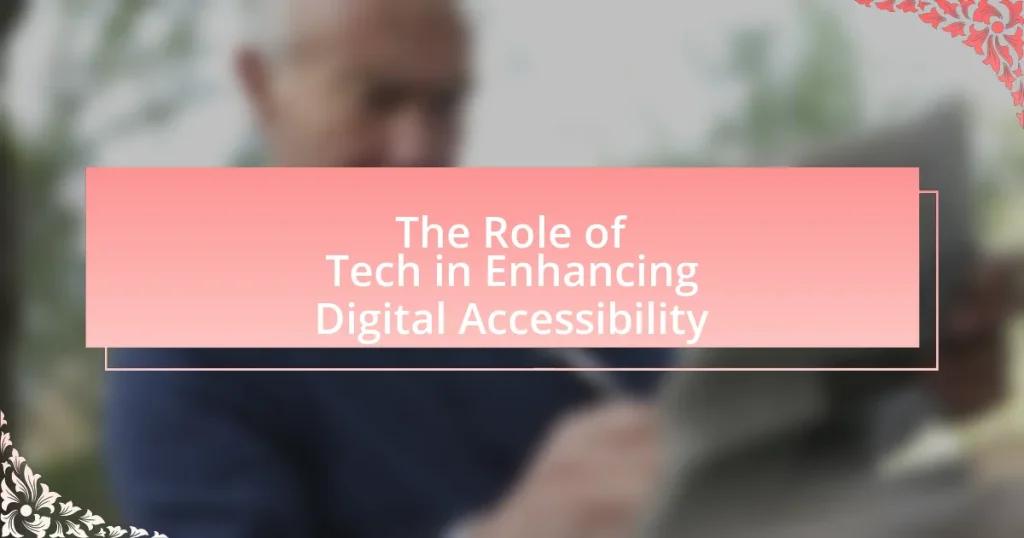The article focuses on the critical role of technology in enhancing digital accessibility for individuals with disabilities. It outlines how assistive technologies, such as screen readers and speech recognition software, facilitate access to digital content, emphasizing the need for inclusive digital environments as over 1 billion people globally experience some form of disability. The article discusses key technologies that support accessibility, the importance of compliance with web accessibility standards like the Web Content Accessibility Guidelines (WCAG), and the legal and ethical implications of digital accessibility. Additionally, it addresses the challenges organizations face in implementing accessible technology and highlights best practices for creating inclusive digital products.

What is the Role of Tech in Enhancing Digital Accessibility?
Technology plays a crucial role in enhancing digital accessibility by providing tools and solutions that enable individuals with disabilities to access digital content effectively. Assistive technologies, such as screen readers, speech recognition software, and alternative input devices, facilitate interaction with websites and applications, ensuring that users with visual, auditory, or motor impairments can navigate and utilize digital resources. According to the World Health Organization, over 1 billion people globally experience some form of disability, highlighting the necessity for inclusive digital environments. Furthermore, web accessibility standards, such as the Web Content Accessibility Guidelines (WCAG), guide developers in creating accessible content, ensuring compliance and usability for all users.
How does technology contribute to digital accessibility?
Technology enhances digital accessibility by providing tools and solutions that enable individuals with disabilities to access digital content and services. Assistive technologies, such as screen readers, speech recognition software, and alternative input devices, allow users with visual, auditory, or motor impairments to interact with websites and applications effectively. According to the World Health Organization, over 1 billion people globally experience some form of disability, highlighting the necessity for inclusive digital environments. Furthermore, web development standards, such as the Web Content Accessibility Guidelines (WCAG), promote the creation of accessible digital content, ensuring that technology serves as a bridge rather than a barrier for users with diverse needs.
What are the key technologies that support digital accessibility?
Key technologies that support digital accessibility include screen readers, alternative text for images, keyboard navigation, and captioning services. Screen readers, such as JAWS and NVDA, convert text to speech, enabling visually impaired users to access content. Alternative text provides descriptions for images, ensuring that users with visual impairments understand visual content. Keyboard navigation allows users to interact with websites and applications without a mouse, which is essential for individuals with mobility impairments. Captioning services, including real-time captioning and subtitles, enhance accessibility for deaf or hard-of-hearing users by providing text representations of audio content. These technologies collectively ensure that digital content is accessible to a diverse range of users, promoting inclusivity and compliance with accessibility standards like the Web Content Accessibility Guidelines (WCAG).
How do these technologies improve user experience for individuals with disabilities?
Technologies improve user experience for individuals with disabilities by providing tailored solutions that enhance accessibility and usability. For instance, screen readers convert text to speech, allowing visually impaired users to navigate websites effectively. Additionally, speech recognition software enables individuals with mobility impairments to control devices and input text hands-free. According to the World Health Organization, over 1 billion people experience some form of disability, highlighting the necessity for such technologies to ensure equal access to information and services. These advancements not only facilitate independence but also promote inclusivity in digital environments.
Why is digital accessibility important in today’s digital landscape?
Digital accessibility is crucial in today’s digital landscape because it ensures that all individuals, regardless of their abilities or disabilities, can access and benefit from online content and services. Approximately 15% of the global population experiences some form of disability, making it essential for businesses and organizations to create inclusive digital environments. Furthermore, legal requirements, such as the Americans with Disabilities Act (ADA) and the Web Content Accessibility Guidelines (WCAG), mandate that digital platforms be accessible, thereby reducing the risk of legal repercussions. Additionally, accessible design can enhance user experience for everyone, leading to increased engagement and customer loyalty.
What are the legal and ethical implications of digital accessibility?
Digital accessibility has significant legal and ethical implications, primarily centered around compliance with laws such as the Americans with Disabilities Act (ADA) and the Web Content Accessibility Guidelines (WCAG). Legally, organizations are required to ensure that their digital content is accessible to individuals with disabilities; failure to comply can result in lawsuits and financial penalties. For instance, the National Federation of the Blind has reported numerous cases where companies faced legal action for inaccessible websites, highlighting the importance of adherence to established standards.
Ethically, digital accessibility promotes inclusivity and equal access to information and services, reflecting a commitment to social responsibility. Organizations that prioritize accessibility demonstrate respect for the rights of individuals with disabilities, fostering a more equitable digital environment. Research indicates that accessible design not only benefits users with disabilities but also enhances overall user experience, thereby supporting ethical business practices.
How does digital accessibility impact businesses and organizations?
Digital accessibility significantly impacts businesses and organizations by expanding their customer base and enhancing user experience. When digital platforms are accessible, they cater to individuals with disabilities, which constitutes approximately 15% of the global population, according to the World Health Organization. This inclusivity not only fosters brand loyalty but also complies with legal standards, such as the Americans with Disabilities Act (ADA) in the United States, which mandates accessible digital content. Furthermore, organizations that prioritize digital accessibility often see improved search engine optimization (SEO) outcomes, as accessible websites tend to rank higher in search results. Thus, investing in digital accessibility can lead to increased revenue, a broader audience reach, and a positive brand reputation.

What are the challenges in implementing technology for digital accessibility?
The challenges in implementing technology for digital accessibility include a lack of awareness, insufficient funding, and the complexity of existing systems. Many organizations are unaware of the legal requirements and best practices for accessibility, which hinders their ability to create inclusive digital environments. Additionally, limited budgets often restrict the resources available for necessary technology upgrades or training. The complexity of integrating accessibility features into existing systems can also pose significant technical challenges, as legacy systems may not support modern accessibility standards. According to a 2020 report by the World Health Organization, over 1 billion people experience some form of disability, highlighting the urgent need for accessible technology solutions.
What common barriers do organizations face in enhancing digital accessibility?
Organizations commonly face several barriers in enhancing digital accessibility, including lack of awareness, insufficient funding, and inadequate technical expertise. Lack of awareness among decision-makers often leads to neglecting accessibility in digital projects, as many organizations do not prioritize it until mandated by law. Insufficient funding restricts the ability to implement necessary changes, as organizations may view accessibility enhancements as non-essential expenses. Additionally, inadequate technical expertise can hinder the development of accessible digital content, as many developers lack training in accessibility standards and best practices. According to a 2020 report by the World Health Organization, approximately 15% of the global population experiences some form of disability, highlighting the critical need for organizations to address these barriers to ensure inclusivity.
How can these barriers be overcome through technology?
Technology can overcome barriers to digital accessibility by implementing adaptive tools and inclusive design principles. For instance, screen readers and voice recognition software enable individuals with visual impairments to navigate digital content effectively. According to the World Health Organization, approximately 2.7 billion people globally experience some form of disability, highlighting the need for accessible technology solutions. Additionally, web accessibility guidelines, such as the Web Content Accessibility Guidelines (WCAG), provide a framework for developers to create content that is usable for everyone, ensuring compliance and enhancing user experience.
What role does user feedback play in addressing these challenges?
User feedback plays a crucial role in addressing challenges related to digital accessibility by providing insights into the real-world experiences of users with disabilities. This feedback helps identify specific barriers that may not be apparent to developers and designers, allowing for targeted improvements. For instance, a study by the World Health Organization indicates that user-centered design, which incorporates feedback from individuals with disabilities, significantly enhances the usability of digital platforms. By actively engaging users in the design process, organizations can create more inclusive technologies that better meet the needs of all users.
How can technology be leveraged to create inclusive digital environments?
Technology can be leveraged to create inclusive digital environments by implementing accessible design principles, utilizing assistive technologies, and ensuring compliance with accessibility standards. Accessible design principles, such as the Web Content Accessibility Guidelines (WCAG), provide a framework for creating content that is perceivable, operable, understandable, and robust for all users, including those with disabilities. Assistive technologies, like screen readers and speech recognition software, enable individuals with visual or mobility impairments to interact with digital content effectively. Compliance with accessibility standards is crucial; for instance, the Americans with Disabilities Act (ADA) mandates that digital services be accessible to individuals with disabilities, reinforcing the need for inclusive practices in technology development.
What are some best practices for integrating accessibility features in digital products?
Best practices for integrating accessibility features in digital products include adhering to the Web Content Accessibility Guidelines (WCAG), which provide a comprehensive framework for making web content more accessible. Implementing features such as keyboard navigation, screen reader compatibility, and alternative text for images ensures that users with disabilities can effectively interact with digital products. Research indicates that approximately 15% of the global population experiences some form of disability, highlighting the necessity for inclusive design. Additionally, conducting user testing with individuals who have disabilities can provide valuable insights and improve the overall accessibility of the product.
How can organizations ensure ongoing compliance with accessibility standards?
Organizations can ensure ongoing compliance with accessibility standards by implementing regular audits and updates of their digital content and platforms. This involves conducting accessibility assessments using automated tools and manual testing to identify and rectify compliance issues. For instance, the Web Content Accessibility Guidelines (WCAG) provide a framework that organizations can follow to meet legal requirements and best practices. Additionally, training staff on accessibility principles and integrating accessibility into the development lifecycle can further reinforce compliance. Research indicates that organizations that prioritize accessibility not only meet legal obligations but also enhance user experience, leading to increased engagement and customer satisfaction.

What are the future trends in technology and digital accessibility?
Future trends in technology and digital accessibility include the increased integration of artificial intelligence, the rise of voice-activated interfaces, and the expansion of augmented and virtual reality applications. Artificial intelligence is enhancing accessibility by providing real-time captioning and translation services, which can significantly improve communication for individuals with hearing impairments. Voice-activated interfaces are becoming more prevalent, allowing users with mobility challenges to navigate devices and applications hands-free. Additionally, augmented and virtual reality technologies are being developed to create immersive experiences that cater to diverse accessibility needs, such as virtual environments for training and education. These trends are supported by the growing emphasis on inclusive design principles in technology development, as evidenced by initiatives like the Web Content Accessibility Guidelines (WCAG) 2.1, which aim to ensure that digital content is accessible to all users.
How is artificial intelligence shaping the future of digital accessibility?
Artificial intelligence is significantly shaping the future of digital accessibility by enabling more personalized and adaptive user experiences for individuals with disabilities. AI technologies, such as natural language processing and machine learning, facilitate real-time captioning, voice recognition, and image recognition, making digital content more accessible. For instance, AI-driven tools like automatic alt text generation for images improve accessibility for visually impaired users, as demonstrated by research from the World Wide Web Consortium, which highlights that such technologies can enhance user engagement and comprehension. Furthermore, AI can analyze user behavior to tailor interfaces that accommodate diverse needs, thereby promoting inclusivity in digital environments.
What innovations are emerging to enhance accessibility for diverse user needs?
Innovations enhancing accessibility for diverse user needs include AI-driven tools, voice recognition technology, and adaptive interfaces. AI-driven tools, such as automated captioning and text-to-speech applications, improve content accessibility for individuals with hearing and visual impairments. Voice recognition technology enables hands-free interaction with devices, benefiting users with mobility challenges. Adaptive interfaces, which adjust based on user preferences and abilities, create personalized experiences that cater to various disabilities. These advancements are supported by research indicating that technology can significantly reduce barriers, as evidenced by a 2021 study from the World Health Organization highlighting the positive impact of digital tools on accessibility.
How can organizations prepare for upcoming changes in accessibility technology?
Organizations can prepare for upcoming changes in accessibility technology by proactively adopting inclusive design principles and staying informed about emerging trends. This involves integrating accessibility into the development process from the outset, ensuring that products and services are usable by individuals with diverse needs. Research indicates that companies that prioritize accessibility can enhance user experience and expand their market reach, as approximately 15% of the global population lives with some form of disability. Additionally, organizations should invest in training for staff on accessibility standards and tools, such as the Web Content Accessibility Guidelines (WCAG), to ensure compliance and foster a culture of inclusivity. By engaging with users who have disabilities during the design and testing phases, organizations can gain valuable insights that lead to more effective and user-friendly solutions.
What practical steps can organizations take to improve digital accessibility?
Organizations can improve digital accessibility by implementing comprehensive accessibility audits and adopting established guidelines such as the Web Content Accessibility Guidelines (WCAG). Conducting accessibility audits helps identify barriers that individuals with disabilities may face when interacting with digital content. Adopting WCAG ensures that websites and applications meet recognized standards, which can enhance usability for all users.
Additionally, organizations should provide training for their staff on accessibility best practices, ensuring that everyone involved in content creation and web development understands the importance of inclusivity. Research indicates that 15% of the global population experiences some form of disability, highlighting the necessity for organizations to prioritize accessibility in their digital strategies.
How can teams effectively assess their current digital accessibility status?
Teams can effectively assess their current digital accessibility status by conducting comprehensive audits using established guidelines such as the Web Content Accessibility Guidelines (WCAG). These audits involve automated testing tools that identify accessibility issues, complemented by manual evaluations to ensure a thorough review of user experience for individuals with disabilities. Research indicates that organizations employing both automated and manual assessments can uncover up to 80% more accessibility issues compared to using automated tools alone, as highlighted in the study “Evaluating Web Accessibility: A Comparative Study of Automated and Manual Testing” by researchers at the University of Illinois. This dual approach enables teams to gain a clear understanding of their digital accessibility landscape and prioritize improvements effectively.
What resources are available for organizations looking to enhance their accessibility efforts?
Organizations looking to enhance their accessibility efforts can utilize a variety of resources, including guidelines from the Web Content Accessibility Guidelines (WCAG), which provide a comprehensive framework for making digital content accessible. Additionally, tools such as accessibility checkers (e.g., Axe, WAVE) help identify and rectify accessibility issues in websites and applications. Training programs and workshops offered by organizations like the International Association of Accessibility Professionals (IAAP) equip staff with the necessary skills to implement accessibility best practices. Furthermore, funding opportunities from government agencies and non-profits, such as the National Institute on Disability, Independent Living, and Rehabilitation Research (NIDILRR), support projects aimed at improving accessibility. These resources collectively empower organizations to create more inclusive digital environments.


